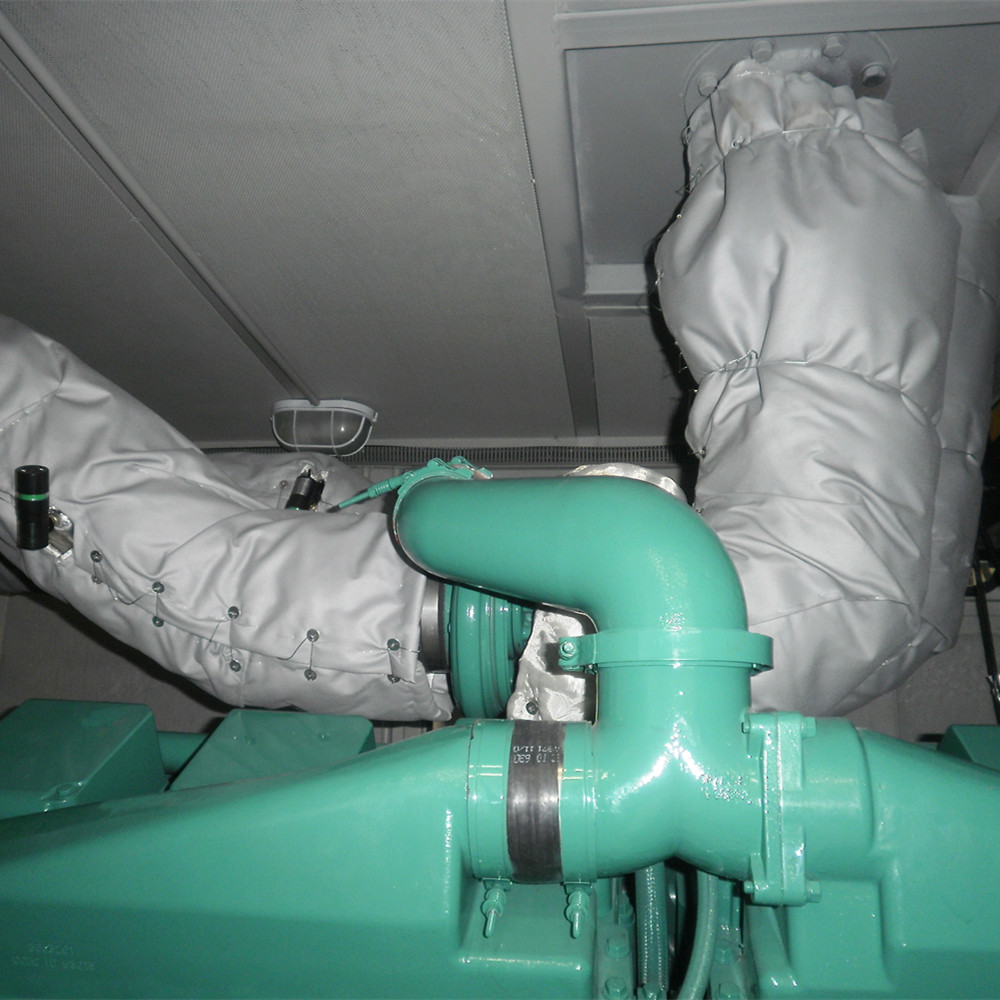µ£Ćķ½śŃü«ń┤ĀµØÉ µÄƵ░Śµ¢Łńå▒Ńā¢Ńā®Ńā│Ńé▒ŃāāŃāł ÕģĘõĮōńÜäŃü¬ńö©ķĆö’╝łõŠŗ’╝ÜĶć¬ÕŗĢĶ╗ŖŃĆüńöŻµźŁŃĆüĶł╣ĶłČ’╝ēŃĆüµĖ®Õ║”Ķ”üõ╗ČŃĆüĶĆÉõ╣ģµĆ¦Ńü«ŃāŗŃā╝Ńé║ŃĆüõ║łń«ŚŃü½ŃéłŃüŻŃü”ńĢ░Ńü¬ŃéŖŃüŠŃüÖŃĆéõ╗źõĖŗŃü»ŃĆüµÄƵ░Śµ¢Łńå▒Ńā¢Ńā®Ńā│Ńé▒ŃāāŃāłŃü½õĮ┐ńö©ŃüĢŃéīŃéŗµ£ĆŃééÕŖ╣µ×£ńÜäŃü¬µØɵ¢ÖŃü©ŃĆüŃüØŃéīŃü×ŃéīŃü«ķĢʵēĆŃü©ń¤ŁµēĆŃü¦ŃüÖŃĆé
µ£Ćķ½śµĖ®Õ║” ’╝Ü ŃüŠŃü¦ 2,200┬░F’╝ł1,200┬░C’╝ē ŃĆé
ķĢʵēĆ ’╝Ü
ĶĆÉńå▒µĆ¦ŃĆüµ¢Łńå▒µĆ¦Ńü½Õä¬ŃéīŃü”ŃüäŃüŠŃüÖŃĆé
Ķ╗ĮķćÅŃüŗŃüżµ¤öĶ╗¤µĆ¦ŃüīŃüéŃéŖŃĆüĶżćķøæŃü¬ÕĮóńŖČŃü½Ńééķü®ÕÉłŃüŚŃüŠŃüÖŃĆé
ńå▒õ╝ØÕ░ÄńÄćŃüīõĮÄŃüÅŃĆüńå▒ŃéÆÕŖ╣µ×£ńÜäŃü½õ┐صīüŃüŚŃüŠŃüÖŃĆé
ń¤ŁµēĆ ’╝Ü
ÕēźŃüīŃéīŃü¤Ńé╗Ńā®Ńā¤ŃāāŃé»ń╣ŖńČŁŃü»ÕÉĖÕģźŃüÖŃéŗŃü©ÕüźÕ║ĘŃā¬Ńé╣Ńé»ŃéÆŃééŃü¤ŃéēŃüÖÕÅ»ĶāĮµĆ¦ŃüīŃüéŃéŗŃü¤ŃéüŃĆüń╣ŖńČŁŃü«Ķä▒ĶÉĮŃéÆķś▓ŃüÉŃü¤ŃéüŃü½Ńé½ŃāŚŃé╗Ńā½Õī¢’╝łŃéĘŃā¬Ńé│Ńā│Ńé│Ńā╝ŃāåŃéŻŃā│Ńé░Ńü¬Ńü®’╝ēŃüīÕ┐ģĶ”üŃü¦ŃüÖŃĆé
õ╗¢Ńü«õ╗Żµø┐ÕōüŃü½µ»öŃü╣Ńü”ĶĆɵæ®ĶĆŚµĆ¦ŃüīõĮÄŃüäŃĆé
µ£Ćķü®Ńü¬ńö©ķĆö : ķ½śµĆ¦ĶāĮĶć¬ÕŗĢĶ╗ŖŃéĘŃé╣ŃāåŃāĀŃĆüŃé┐Ńā╝Ńā£ŃāüŃāŻŃā╝ŃéĖŃāŻŃā╝ŃĆüńöŻµźŁńö©µÄƵ░ŚĶŻģńĮ«ŃĆé
µ£Ćķ½śµĖ®Õ║” ’╝Ü ŃüŠŃü¦ 1,800┬░F’╝ł1,000┬░C’╝ē ŃĆé
ķĢʵēĆ ’╝Ü
ńå▒ŃĆüÕī¢ÕŁ”Ķ¢¼ÕōüŃĆüµ╣┐µ░ŚŃü½Õ»ŠŃüŚŃü”Ķć¬ńäČŃü¬ĶĆɵƦŃüīŃüéŃéŖŃüŠŃüÖŃĆé
ńäĪµ»ÆŃü¦ńÆ░ÕóāŃü½Õä¬ŃüŚŃüäŃĆé
ĶĆÉõ╣ģµĆ¦ŃĆüĶĆɵī»µĆ¦Ńü½Õä¬ŃéīŃü”ŃüäŃüŠŃüÖŃĆé
ń¤ŁµēĆ ’╝Ü
ŃéĘŃā¬Ńé½/Ńé╗Ńā®Ńā¤ŃāāŃé»ń╣ŖńČŁŃéłŃéŖĶŗźÕ╣▓ķćŹŃüäŃü¦ŃüÖŃĆé
Ńé░Ńā®Ńé╣ŃāĢŃéĪŃéżŃāÉŃā╝Ńü½µ»öŃü╣Ńü”ÕģźµēŗÕÅ»ĶāĮµĆ¦ŃüīķÖÉŃéēŃéīŃü”ŃüäŃüŠŃüÖŃĆé
µ£Ćķü®Ńü¬ńö©ķĆö : ĶĆÉõ╣ģµĆ¦Ńü©Õ«ēÕģ©µĆ¦ŃüīÕä¬ÕģłŃüĢŃéīŃéŗÕż¦Õ×ŗńö©ķĆö (ŃāłŃā®ŃāāŃé»ŃĆüńöŻµźŁµ®¤µó░)ŃĆé
µ£Ćķ½śµĖ®Õ║” ’╝Ü ŃüŠŃü¦ 1,200┬░F’╝ł650┬░C’╝ē ŃĆé
ķĢʵēĆ ’╝Ü
Ńé│Ńé╣ŃāłÕŖ╣ńÄćŃüīķ½śŃüÅŃĆüÕ║āŃüÅÕģźµēŗÕÅ»ĶāĮŃü¦ŃüÖŃĆé
Ķ╗ĮķćÅŃü¦ÕÅ¢ŃéŖõ╗śŃüæŃééń░ĪÕŹśŃü¦ŃüÖŃĆé
ĶĆɵ░┤µĆ¦ŃéäĶĆɵ▓╣µĆ¦ŃéÆķ½śŃéüŃéŗŃü¤ŃéüŃü½ŃéĘŃā¬Ńé│Ńā│Ńéäń«öŃü¦Ńé│Ńā╝ŃāåŃéŻŃā│Ńé░ŃüĢŃéīŃü”ŃüäŃéŗŃüōŃü©ŃüīÕżÜŃüäŃü¦ŃüÖŃĆé
ń¤ŁµēĆ ’╝Ü
Ńé╗Ńā®Ńā¤ŃāāŃé»ń╣ŖńČŁŃéäńÄ䵣”Õ▓®ń╣ŖńČŁŃéłŃéŖŃééĶĆÉńå▒µĆ¦ŃüīõĮÄŃüäŃĆé
µ▓╣Ńéäńćāµ¢ÖŃĆüµ╣┐µ░ŚŃü½ŃüĢŃéēŃüĢŃéīŃéŗŃü©µÖéķ¢ōŃü«ńĄīķüÄŃü©Ńü©ŃééŃü½ÕŖŻÕī¢ŃüŚŃüŠŃüÖŃĆé
µ£Ćķü®Ńü¬ńö©ķĆö : õĖŁń©ŗÕ║”Ńü«ńå▒Ńā¼ŃāÖŃā½ŃéÆÕéÖŃüłŃü¤ŃĆüõ║łń«ŚŃü½Õä¬ŃüŚŃüäĶć¬ÕŗĢĶ╗ŖŃüŠŃü¤Ńü»Ķł╣ĶłČŃü«µÄƵ░ŚŃéĘŃé╣ŃāåŃāĀŃĆé
µ£Ćķ½śµĖ®Õ║” ’╝Ü ŃüŠŃü¦ 2,000┬░F’╝ł1,100┬░C’╝ē ŃĆé
ķĢʵēĆ ’╝Ü
ķØ×ÕĖĖŃü½õĮÄŃüäńå▒õ╝ØÕ░ÄńÄć’╝łŃé»Ńā®Ńé╣µ£Ćķ½śŃü«µ¢Łńå▒µĆ¦’╝ēŃĆé
ĶČģĶ¢äÕ×ŗŃĆüĶ╗ĮķćÅŃü¬Ńü«Ńü¦ńŗŁŃüäŃé╣ŃāÜŃā╝Ńé╣Ńü½µ£Ćķü®Ńü¦ŃüÖŃĆé
µ╣┐µ░ŚŃéäÕī¢ÕŁ”ńē®Ķ│¬Ńü½ĶĆɵƦŃüīŃüéŃéŖŃüŠŃüÖŃĆé
ń¤ŁµēĆ ’╝Ü
õ╗¢Ńü«ń┤ĀµØÉŃü½µ»öŃü╣Ńü”ķØ×ÕĖĖŃü½ķ½śõŠĪŃü¦ŃüÖŃĆé
Ńé░Ńā®Ńé╣ŃāĢŃéĪŃéżŃāÉŃā╝ŃüŠŃü¤Ńü»ŃéĘŃā¬Ńé│Ńā│Ńā×ŃāłŃā¬ŃāāŃé»Ńé╣Ńü½ķü®ÕłćŃü½Õ░üÕģźŃüĢŃéīŃü”ŃüäŃü¬ŃüäÕĀ┤ÕÉłŃü»ÕŻŖŃéīŃéäŃüÖŃüÅŃü¬ŃéŖŃüŠŃüÖŃĆé
µ£Ćķü®Ńü¬ńö©ķĆö : Ńé╣ŃāÜŃā╝Ńé╣Ńü©ķćŹķćÅŃüīķćŹĶ”üŃü©Ńü¬Ńéŗķ½śÕŖ╣ńÄćŃéóŃāŚŃā¬Ńé▒Ńā╝ŃéĘŃā¦Ńā│ (õŠŗ: Ķł¬ń®║Õ«ćÕ«ÖŃĆüŃā¼Ńā╝Ńé╣)ŃĆé
µ£Ćķ½śµĖ®Õ║” ’╝Ü ŃüŠŃü¦ 1,500┬░F’╝ł815┬░C’╝ē ŃĆé
ķĢʵēĆ ’╝Ü
ĶĆÉõ╣ģµĆ¦Ńü©ĶĆɵæ®ĶĆŚµĆ¦Ńü½Õä¬ŃéīŃü”ŃüäŃüŠŃüÖŃĆé
µöŠÕ░äńå▒ŃéÆÕÅŹÕ░äŃüŚŃĆüńē®ńÉåńÜäŃü¬µÉŹÕéĘŃüŗŃéēõ┐ØĶŁĘŃüŚŃüŠŃüÖŃĆé
ŃāÅŃéżŃā¢Ńā¬ŃāāŃāēµ¢Łńå▒µØÉŃü©ŃüŚŃü”Ńé╗Ńā®Ńā¤ŃāāŃé»ń╣ŖńČŁŃü©ńĄäŃü┐ÕÉłŃéÅŃüøŃéēŃéīŃéŗŃüōŃü©ŃüīÕżÜŃüäŃĆé
ń¤ŁµēĆ ’╝Ü
ń╣ŖńČŁŃāÖŃā╝Ńé╣Ńü«µ»øÕĖāŃéłŃéŖŃééķćŹŃüÅŃĆüµ¤öĶ╗¤µĆ¦ŃüīõĮÄŃüäŃü¦ŃüÖŃĆé
ķćæÕ▒×ķā©ÕōüŃü«Ńü¤ŃéüŃé│Ńé╣ŃāłŃüīķ½śŃüÅŃü¬ŃéŖŃüŠŃüÖŃĆé
µ£Ćķü®Ńü¬ńö©ķĆö : ńöŻµźŁµÄƵ░ŚŃé¼Ńé╣ŃĆüĶł╣ĶłČŃé©Ńā│ŃéĖŃā│ŃĆüŃüŠŃü¤Ńü»µ®¤µó░ńÜäµæ®ĶĆŚŃü«Ńā¬Ńé╣Ńé»ŃüīŃüéŃéŗńÆ░ÕóāŃĆé
µ£Ćķ½śµĖ®Õ║” ’╝Ü ŃüŠŃü¦ 1,600┬░F’╝ł870┬░C’╝ē ŃĆé
ķĢʵēĆ ’╝Ü
µ¢Łńå▒µĆ¦Ńü©ĶĆÉńü½µĆ¦Ńü½Õä¬ŃéīŃü”ŃüäŃüŠŃüÖŃĆé
ńäĪµ»ÆŃü¦ńÆ░ÕóāńÜäŃü½Õ«ēÕ«ÜŃüŚŃü”ŃüäŃüŠŃüÖŃĆé
ń¤ŁµēĆ ’╝Ü
Ńé╗Ńā®Ńā¤ŃāāŃé»ŃéäŃé©ŃéóŃāŁŃé▓Ńā½Ńü«Ńé¬ŃāŚŃéĘŃā¦Ńā│ŃéłŃéŖŃééŃüŗŃüĢŃü░ŃéŖŃüŠŃüÖŃĆé
µ£Ćķü®Ńü¬ńö©ķĆö : õĖŁń©ŗÕ║”Ńü«µ¢Łńå▒ŃéÆÕ┐ģĶ”üŃü©ŃüÖŃéŗÕĘźµźŁńö©Ńé¬Ńā╝Ńā¢Ńā│ŃĆüńÖ║ķø╗µ®¤ŃĆüŃüŠŃü¤Ńü»ŃéĘŃé╣ŃāåŃāĀŃĆé
µĖ®Õ║”ń»äÕø▓ : µØɵ¢ÖŃü«µ£Ćķ½śµĖ®Õ║”ŃéƵÄƵ░ŚĶŻģńĮ«Ńü«ÕŗĢõĮ£ńå▒Ńü½ÕÉłŃéÅŃüøŃüŠŃüÖ’╝łÕ«ēÕģ©Ńā×Ńā╝ŃéĖŃā│ŃéÆÕɽŃéüŃüŠŃüÖ’╝ēŃĆé
ńÆ░ÕóāŃüĖŃü«µøØķ£▓ : µ╣┐µ░ŚŃĆüÕī¢ÕŁ”Ķ¢¼ÕōüŃĆüµ▓╣Ńü¬Ńü®Ńü½Õ»ŠŃüŚŃü”Ńü»ŃĆüŃéĘŃā¬Ńé│Ńā│Ńé│Ńā╝ŃāåŃéŻŃā│Ńé░ŃüŠŃü¤Ńü»Ńé╣ŃāåŃā│Ńā¼Ńé╣ķŗ╝Ńā®Ńā¤ŃāŹŃā╝ŃāłŃü«Ńé¬ŃāŚŃéĘŃā¦Ńā│ŃüīÕ┐ģĶ”üŃü½Ńü¬ŃéŗÕĀ┤ÕÉłŃüīŃüéŃéŖŃüŠŃüÖŃĆé
ĶĆÉõ╣ģµĆ¦ µī»ÕŗĢŃĆüµæ®ĶĆŚŃĆüµ®¤µó░ńÜäŃé╣ŃāłŃā¼Ńé╣Ńü½Ńü»ŃĆüńÄ䵣”Õ▓®ŃĆüŃé╣ŃāåŃā│Ńā¼Ńé╣ķŗ╝ŃĆüŃüŠŃü¤Ńü»ŃāÅŃéżŃā¢Ńā¬ŃāāŃāē Ńā¢Ńā®Ńā│Ńé▒ŃāāŃāłŃüīķü®ŃüŚŃü”ŃüäŃüŠŃüÖŃĆé
Õ«ēÕģ©µĆ¦ : ÕüźÕ║ĘŃā¬Ńé╣Ńé»ŃüīŃüéŃéŗŃü¤ŃéüŃĆüõ║║ķ¢ōŃüīµÄźĶ¦”ŃüÖŃéŗÕĀ┤µēĆŃü¦Ńü»ŃĆüń╣ŖńČŁŃü«µŖ£ŃüæŃü¤ń┤ĀµØÉ’╝łŃé│Ńā╝ŃāåŃéŻŃā│Ńé░ŃüĢŃéīŃü”ŃüäŃü¬ŃüäŃé╗Ńā®Ńā¤ŃāāŃé»ń╣ŖńČŁŃü¬Ńü®’╝ēŃü«õĮ┐ńö©ŃéÆķü┐ŃüæŃü”ŃüÅŃüĀŃüĢŃüäŃĆé
Ķ”ÅÕłČŃé│Ńā│ŃāŚŃā®ŃéżŃéóŃā│Ńé╣ : µØɵ¢ÖŃüīµźŁńĢīµ©Öµ║¢ (õŠŗ: Ķć¬ÕŗĢĶ╗Ŗńö© SAE J2308) ŃéƵ║ĆŃü¤ŃüŚŃü”ŃüäŃéŗŃüōŃü©ŃéÆńó║Ķ¬ŹŃüŚŃüŠŃüÖŃĆé
ķ½śµĆ¦ĶāĮĶć¬ÕŗĢĶ╗Ŗ’╝łŃé┐Ńā╝Ńā£/ŃāśŃāāŃāĆŃā╝’╝ē : ŃéĘŃā¬Ńé│Ńā│Ńé│Ńā╝ŃāåŃéŻŃā│Ńé░ŃéƵ¢ĮŃüŚŃü¤ŃéĘŃā¬Ńé½Ńé╗Ńā®Ńā¤ŃāāŃé»ŃāĢŃéĪŃéżŃāÉŃā╝Ńā¢Ńā®Ńā│Ńé▒ŃāāŃāłŃĆé
ńöŻµźŁ/µĄĘµ┤ŗ : ńÄ䵣”Õ▓®ń╣ŖńČŁŃüŠŃü¤Ńü»Ńé╣ŃāåŃā│Ńā¼Ńé╣ķŗ╝ń®ŹÕ▒żŃā¢Ńā®Ńā│Ńé▒ŃāāŃāłŃĆé
ŃāÉŃéĖŃé¦ŃāāŃāłŃā╗Ńé¬Ńā╝ŃāłŃāóŃā╝ŃāåŃéŻŃā¢ : ŃéĘŃā¬Ńé│Ńā│Ńé│Ńā╝ŃāåŃéŻŃā│Ńé░ŃüĢŃéīŃü¤Ńé░Ńā®Ńé╣ŃāĢŃéĪŃéżŃāÉŃā╝ŃĆé
ĶČģķ½śÕŖ╣ńÄć/Ńé│Ńā│ŃāæŃé»ŃāłŃéĘŃé╣ŃāåŃāĀ : Ńé©ŃéóŃāŁŃé▓Ńā½ĶżćÕÉłŃā¢Ńā®Ńā│Ńé▒ŃāāŃāłŃĆé
ŃāæŃāĢŃé®Ńā╝Ńā×Ńā│Ńé╣Ńü©Õ«ēÕģ©µĆ¦ŃéÆńČŁµīüŃüÖŃéŗŃü½Ńü»ŃĆüķü®ÕłćŃü¬ÕÅ¢ŃéŖõ╗śŃüæ’╝łķ½śµĖ®Ńé╣ŃāłŃā®ŃāāŃāŚŃéäŃé»Ńā®Ńā│ŃāŚŃü«õĮ┐ńö©Ńü¬Ńü®’╝ēŃü©Õ«Üµ£¤ńÜäŃü¬µż£µ¤╗ŃüīķćŹĶ”üŃü¦ŃüÖŃĆé
